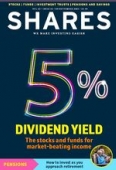Archived article
Please note that tax, investment, pension and ISA rules can change and the information and any views contained in this article may now be inaccurate.
Watch margin debt as tech giants keeps powering S&P 500

The S&P 500 index continues to barrel higher, setting fresh peaks as it does so. The American benchmark has advanced for seven straight months, its best run without a loss since its 10-month romp between April 2017 and January 2018, even if some of the market technicals have not convinced everyone.
As this column noted last month, the small-cap Russell 2000 index and the Dow Jones Transportation index have yet to set fresh peaks, to imply the current advance lacks the breadth that provides confidence in the foundations of the upward move.
In this context it is interesting to note the first dip in US margin debt since February 2020, just as the pandemic hit and investor confidence quickly drained away.
Margin debt is the amount of money an investor borrows from their broker via a margin account to buy shares (or even short sell them).
This looks smart when markets are rising (as the investor or trader can get more exposure) but looks less clever when markets are falling. Indeed, falling asset prices can force so-called margin calls where the investor or trader must start repaying the loan – and sometimes they must sell other positions to fund that repayment, creating a negative feedback loop in markets.
This first dip in margin debt must be watched, especially in light of Securities and Exchange Commission queries about regulatory filings from the investment platform Robinhood and questions about its business model and whether payment for order flow is appropriate.
It remains to be seen whether this dampens some of the liquidity flow which has done so much to elevate certain sections of the US stock market but it may be no coincidence that what looked like some of the frothier areas have started to flag.

HOT AND COLD
Whether trading losses are sparking a slight decrease in risk appetite or whether a more cautionary approach (perhaps considering Federal Reserve reverse repo operations and talk of tapering) is lessening demand for initial public offerings, cash shells known as SPACs and growth and tech stocks is hard to divine.
But what is clear is that some of the hottest areas of the US market are showing some sign of cooling.
New market entrants have started to lose their appeal, judging by the performance of the Renaissance IPO ETF and Renaissance International IPO ETF. The former is currently tracking the performance of 72 American new floats, the latter 62 global ones.
The International vehicle may be suffering owing to its 44% weighting toward China and the US-oriented version is at least trying to claw back lost ground.

Enthusiasm for cash shells set up to acquire what they fancy is also waning. The Next Gen Defiance SPAC Derived ETF, which tracks a basket of nearly 300 SPACs is down by more than a third from its high.
This is perhaps less of a surprise when you consider the data from SPACinsider.com which shows how 308 SPACs are looking for a target even though 263 have already floated. In the end, supply may be outstripping demand.
Even Cathie Wood’s ARK Innovation ETF, the darling of growth and momentum-seekers, has found the going to be a bit tougher of late. The $22 billion behemoth, whose biggest holdings are Tesla, Teladoc and Roku, trades a fifth below its high (although supporters will counter that it is up by a quarter from its spring lows).
None of this is conclusive and the attempted rallies in the ARK Innovation ETF and the Renaissance IPO ETF could yet signal the next upward surge in US equities. Investors would do well to keep an eye on them and trends on the monthly margin debt figure from FINRA as useful indicators of market sentiment.
Yet for the US market to really roll-over its leaders must falter. And in fairness there is little sign yet of investors falling out of love with Facebook, Apple, Amazon, Netflix, Google’s parent Alphabet and Microsoft.

Their aggregate $9.8 trillion market cap is the equivalent of more than three times that of the FTSE 100 and they represent a quarter of the S&P 500’s value between them. If the S&P is to stumble, these names will have to do so.
Spotting what could cause that is the hard bit, such is their dominance, and in the absence of regulation it may take a jump in interest rates or a wider, unexpected shock to prompt investors to sell such core holdings, just as happened with the oil price shock and inflation in 1973-74.
This did for the previously unassailable ‘Nifty Fifty’, an informal designation for 50 popular large-cap stocks in the 1960s and 1970s.
Important information:
These articles are provided by Shares magazine which is published by AJ Bell Media, a part of AJ Bell. Shares is not written by AJ Bell.
Shares is provided for your general information and use and is not a personal recommendation to invest. It is not intended to be relied upon by you in making or not making any investment decisions. The investments referred to in these articles will not be suitable for all investors. If in doubt please seek appropriate independent financial advice.
Investors acting on the information in these articles do so at their own risk and AJ Bell Media and its staff do not accept liability for losses suffered by investors as a result of their investment decisions.

 magazine
magazine








